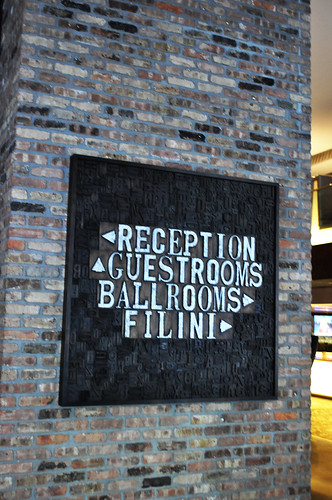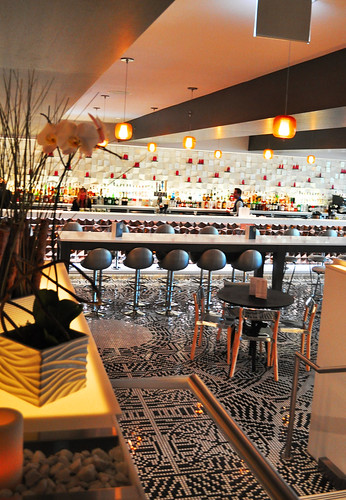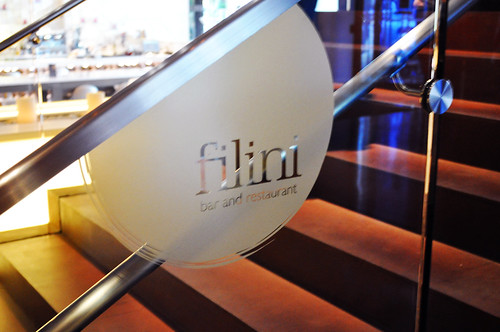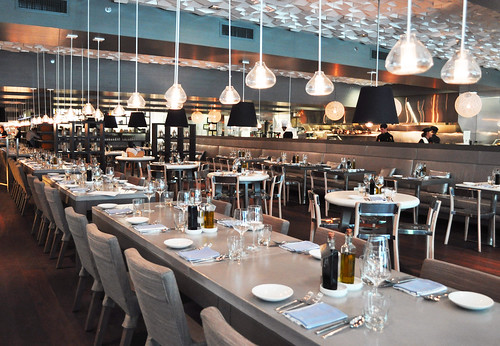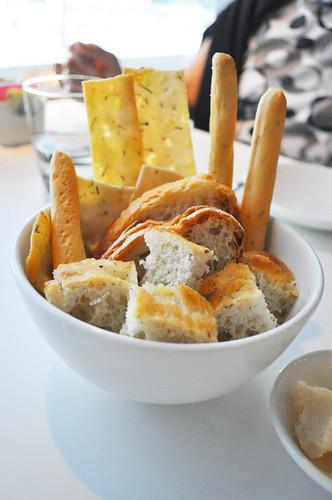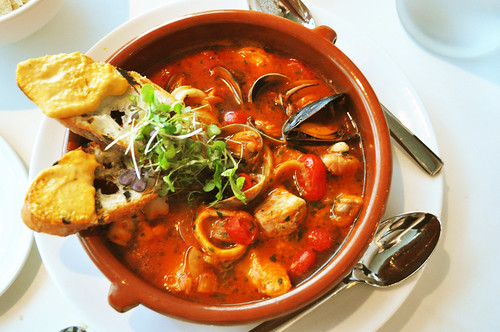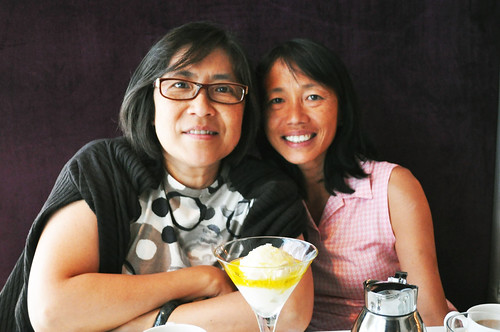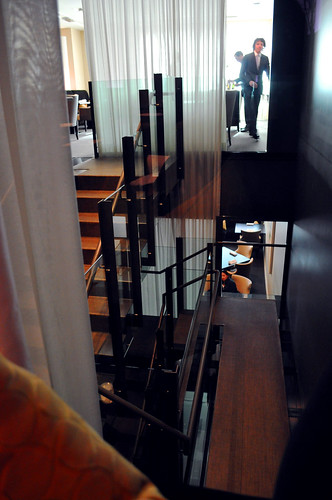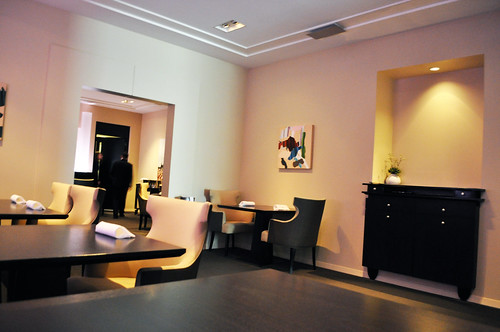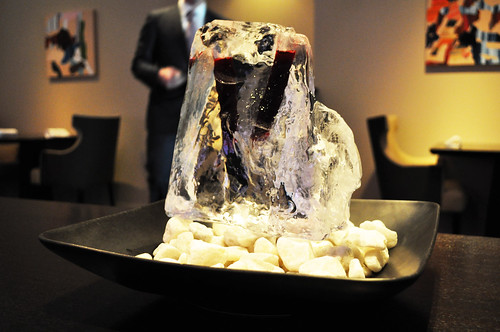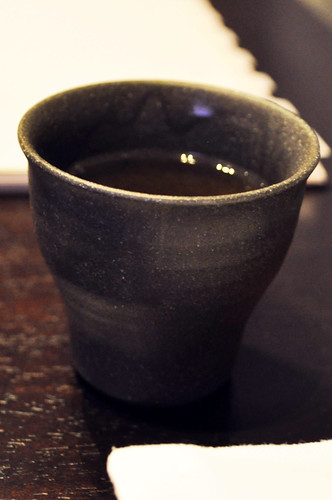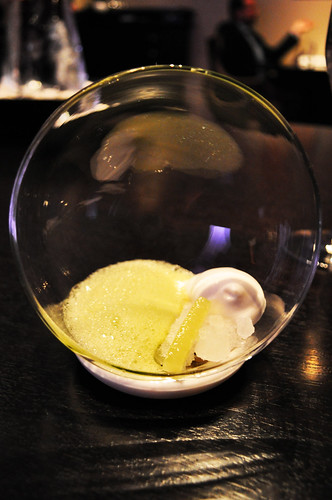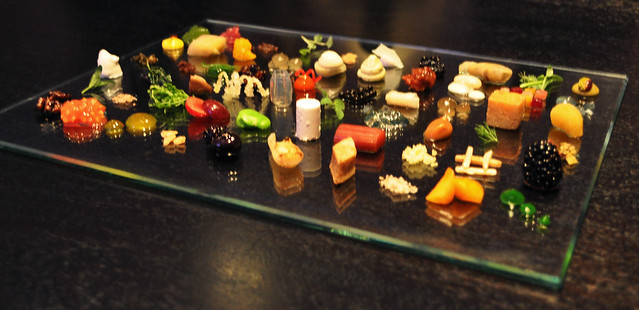Marcus and I decided to make Chicago the destination of our annual spring holiday together. He had never been before, and since my kai family (Cantonese equivalent of "god family") lives there, we thought it'd be nice to visit them as well as to check out downtown Chicago. Whilst planning our trip, the inevitable came up -- would we even try to get tickets to Chef Grant Achatz and Nick Kokonas' new restaurant, Next, which would be nearing the end of its "season" of the elBulli reincarnation? Well, after the logistics and details were finally released out to the public, the steep price of $365 per person via "ticket system" and its policy of "season tickets" made it pretty impossible already before we even attempted to try. The next logical question was if we wanted to try to make reservations at Alinea. Though I had already been back in October 2010, I certainly wanted Marcus to experience firsthand himself, if that's what he wanted. After tossing around the idea of possibly going the alternative route (Moto, L2O, Schwa, Spiaggia, etc.), we kept coming back to Alinea. Marcus's train of thought was if we were already going to be there, might as well make the trip.

Once again, we didn't book plane tickets (in the same way we planned for The French Laundry) for Chicago until we secured a reservation. Yup, we're those annoying, hardcore foodies that you hear about. But seriously -- why limit yourself when booking airfare to one of the busiest airports in the United States when scoring a reservation at one of the best restaurants in North America (and in the world) is so much harder? As I've mentioned before, the restaurant's policy is that all reservations for a desired month are open to the public on the date of the 1st, two months prior, at 10 AM, Central Time. So, there I was, back at the phone, just as I was a year and a half ago, readying myself for the incessant phone calls ahead, just to get through to the maître d' on March 1 at 11 AM, Eastern Time, for a May reservation. We were met with busy signals -- typical, of course -- so to break up this high-stress situation, Marcus (being the humorous chap he is) sent me a poem he had just ad-libbed on the spot:
Marcus: (my poem for Alinea, in the style of ee cummings)
BEEEEEP
BEEEEEP
BEEEEEP
BEEEEEP
BEEEEEP
It certainly was a test of our patience once again, as we lamented to each other the endless encounters of busy signals. It was right about then (a measly thirty minutes later) that I was patched through to an automated message followed by a hurried receptionist who promptly put me on hold. At last -- a glimmer of hope! I waited and waited, worried that I would somehow become disconnected and lose my spot. Thankfully, it only took a few minutes (though those mere minutes seemed like hours) for the maître d' to return and assist me. I was expecting some great difficulties in landing a reservation, so when she asked me what date and time I was thinking of, I just said any day in May for a party of two. She casually replied that the restaurant was pretty open, since reservations just opened up, so she asked me just to pick a day. I had originally picked May 17, around 6 PM, to which she said was free. There I had it -- landed yet another reservation at Alinea, with barely a hitch! Even when I had to alter our reservation for the next night (May 17), calling back wasn't too much of a problem -- about five minutes -- and neither was changing the reservation completely (May 17 at 5:45 PM). A little tip from personal experience and fellow foodie friends -- it seems as though parties of two are easier to get than larger sized parties (i.e., four and up).
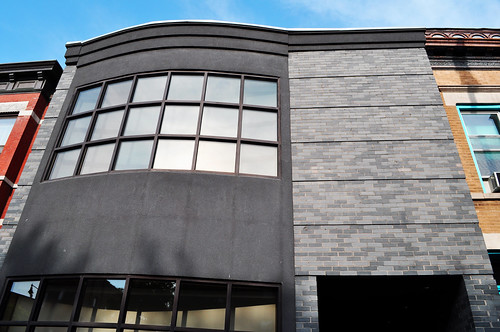
We arrived to Chicago the day before our reservation, and all was well. That is, up until the morning of our reservation. Marcus and I encountered a little bit of a snafu on the day of our reservation. Marcus woke up with excruciating pain in his elbow around 5:30 AM, contemplating whether it was dislocated or not -- not a great start to what we had hoped to be a promising and delicious day. Next thing we know, we were sitting in the emergency room, waiting for a diagnosis from the doctor on duty. Thankfully nothing was broken or dislocated -- just a really painfully tender olecranon bursitis, i.e., inflammation of the bursa sac around the elbow. With arm in sling and given the proper regimen of anti-inflammatories and antibiotics, Marcus left the ER, still feeling feverish and suffering lots of pain in his arm. The plans we had to go into downtown Chicago were a no-go and making our reservation at Alinea was looking very dim. However, a few hours later, things were beginning to look up. With Marcus's medication working effectively, a reliable car service, and much better spirits, we were on our way to Alinea by late afternoon.

We arrived to Lincoln Park about fifteen minutes before our reservation, so we walked around the entrance a bit, taking the usual photos. There was a gentleman standing nearby, who was waiting in front of the restaurant as well and saw us snapping away. He generously asked if we wanted a photograph together, so there we stood -- me with an aircast boot for my hairline fracture that came about several weeks ago, and Marcus behind, attempting to hide his slung arm. Yup, a cripply couple of foodies we were -- but hey, we finally made it to Alinea, in one piece, so to speak.
We were promptly seated on the second level, in the middle dining area, which gave a completely different perspective of the restaurant's space than my last visit (where I was seated near the second story window).
Inside the middle dining room on the second floor. Love the black and beige theme -- very comfortable and easy on the eyes. The minimalist décor was just as I remembered it -- clean cut and geometrical. I remember reading a very noteworthy conversation between Chef Achatz and Mr. Kokonas in Life, On the Line, their joint memoir, about these very tables, told from Mr. Kokonas' point of view: “‘Do you know why four-star restaurants have tablecloths?’ Grant asked me as we started into our conversation.
‘I suppose it's because it feels luxurious. Fine white linens look and feel good. They are soft to the touch, beautifully made…’
Grant interrupted, ‘No, not really. It's because the table under the tablecloth is shitty. It's usually a piece of plywood bound to a wobbly base that is cheap and barely balanced. You may not recognize that consciously, but you know it, you can feel it.’
‘You know what I want?’ Grant asked, not waiting for my answer. ‘I want beautiful tables. Bare tables. Black ones.’ […]
‘Totally bare tables?’ I asked.
‘Yeah. It would look really striking and different. The plates and stainless will pop against the wood. It will feel strong under your hands.’ Grant clearly had pictured all this in his head a thousand times. I could see that the business plan was irrelevant compared to the vision he had in his head.
‘Is there a four-star restaurant anywhere with bare tables? Where do you put the silverware? What about water when glass sweats and it goes all over the wood with nothing to absorb it?’ My list of concerns was long. […]
We consulted Google. In this case, the quick survey was that no, there was not a top-30 restaurant in the world that had bare tables. The dew point of water could be calculated with a simple formula, and we could refrigerate water just above that temperature so that a glass would not sweat when placed on the table. Laundering fine linens for twenty-two tables, fifty weeks a year would cost approximately $42,000 annually. We could build mahogany tables for less. It all made perfect sense.
And just like that we had our first design mantra for the new restaurant -- no tablecloths.”
Chef Achatz was right -- the tables were indeed beautiful and sturdy, and boy, did each course pop, as did the serviceware on which each rested.
In true Alinea fashion, the centerpiece was certainly a conversation starter -- a large slab of ice with a mysterious, deep red liquid filling its two hollowed and vertical wells, over a pile of white pebbles.
Gorgeously displayed on the cover of the famed Alinea cookbook, the silverware pillow sat on the black mahogany tables. Guess the restaurant found a solution for Mr. Kokonas' concern with where the silverware would go! :P
Instead of going with the wine pairing, I decided to easy that evening. After opting for the wine pairing the first time around, I strongly suggest only the boldest of drinkers out there dare to go for the pairing -- it was a lot of drinking, and by the end of my meal, however awesome it was, I was really drunk and happily woozy. Needless to say, hangover ensued the following day.
{1} So to be safe, I began with a champagne cocktail, while {2} Marcus went the non-alcoholic route with a homemade ginger soda. Please also note that Alinea did a fine job with none of our water glasses sweated one drop of condensation on itself or on the table. It's all in the details -- that's for sure!
Each course listed on the tasting menu is denoted by the singular, focal ingredient contained within it. In between each denotation and the other comprised ingredients within that course is a circle (called "flavor markers" by Chef Achatz and Mr. Kokonas), that wavers in size (i.e., representing portion size -- smaller for a small bite, larger for larger portions) and direction (i.e., left is for more savory courses, while right is for courses on the sweeter side).
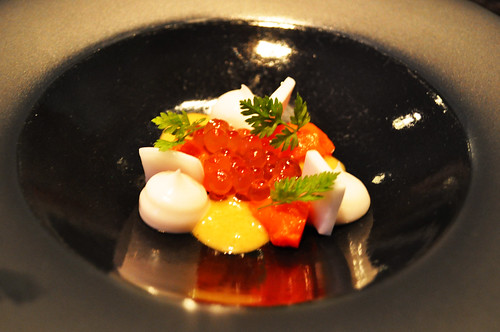
The first course was
steelhead roe, a rendition with carrot gélee, young coconut, and yuzu-curry emulsion. The use of roe, whether it be of steelhead, golden trout, or another origin, as the first course seems to be Chef Achatz's modus operandi. If I recall correctly, one of the captains described this course as the chef's ode to the first chef for whom he worked. I have to be sure to listen a little more carefully next time for that detail! Anyway, the flavors worked harmoniously together to create a whirlwind of culinary euphony. The briny-ness from the roe pearls, the silky texture from the carrot, and the delicate citrus overlaying the South Asian curried flavors was surprisingly palatable. The ability of the kitchen at Alinea to formulate such strikingly delicious and aesthetic flavors reminded me of one of the restaurant's YouTube videos about flavor bouncing, whereby the kitchen team bouncing flavors off each other to create new dishes -- really fascinating stuff. With that being said, I wish we had one more bite of this to savor.
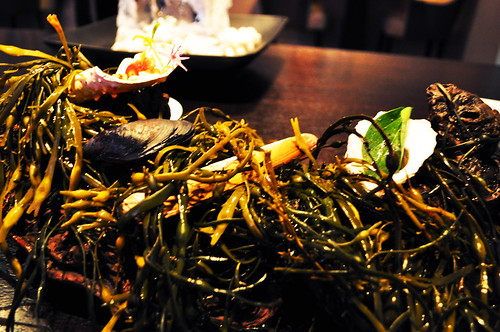
The next course reminded me very much of the maitake dish I had previously, where the dish somehow creates not only the traditional gustatory experience (via the palate) but also with the other senses (via the nose and eyes). The assortment of four shellfish (both figuratively and literally) were placed artistically on what appeared to be a log (incidentally Malaysian driftwood) wrapped completely in seaweed. We were instructed to begin with the "oyster leaf" mignonette at the far right, working our away across with our hands, cautioning that the shellfish may be sharp at times. The "oyster leaf" was very interesting, obvious even at the first glimpse -- oysters don't have leaves! Our captain informed us that this leaf, native to Scotland, was flavored to taste like an oyster, but obviously there was no oyster at hand -- just the flavored leaf cleverly plated on an oyster half-shell. It was alarmingly easy to eat -- almost like the most delicate of potato chips. While I was figuring out the bivalves, Marcus went straight for the Alaskan king crab with passionfruit, heart of palm, allspice, and cilantro -- very juicy as expected with a tropical underlying flavor.

{1} The mussel with orange-saffron emulsion, chorizo, and oregano was divine -- slid happily onto our palates and into our delighted stomachs -- meaty, earthy, and paella-inspired. {2} Our captain suggested that we use its oblong shell as a luge of sorts, letting gravity do the rest of the work. We did just that, letting the shiso, daikon, and of course, the razor clam glide down the against the stream of soy sauce right into our mouths. While the idea in theory was great, I felt there was too much soy sauce and not enough razor clam (I couldn't even taste it)! Can't beat three out of four winners, though!
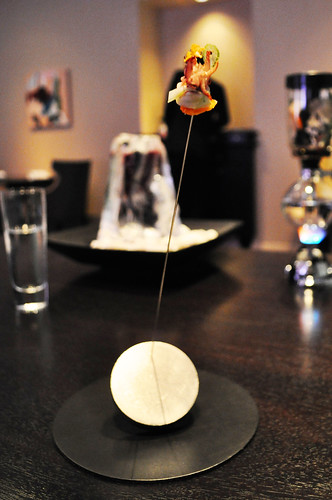
New serviceware (I assume by designer Martin Kastner of Crucial Detail) continued to show up at our table throughout the course of the meal, with this little gizmo -- the "Antenna" -- dangling some woolly pig with fennel, orange, and baby squid. Instructions for this puppy? No hands! Just lean forward and nom in one bite. For a little morsel like that, it was sure complex all around -- taste, texture, flavor, etc. The
woolly pig (from Hungary -- cured longer than Spanish iberico ham) had a pancetta-bacon kind of attitude to it -- crispy with a little slick of grease -- and the lightly charred curlicues of the baby squid had a balanced overlay of smokiness to it. So with all of that to digest (both literally and figuratively), it was one intense bite!
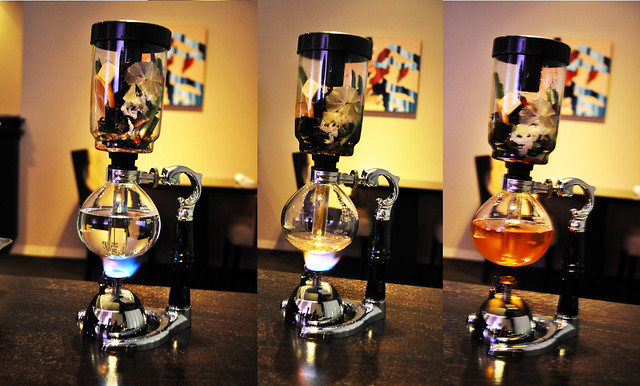
Shortly before the service team had brought over some contraption that belongs in a laboratory of sorts. As it turns out, it was a coffee siphon -- an apparatus with its two chambers that uses a mechanism of vapor pressure and vacuum produces coffee. {1} In this case, dashi, Japanese cooking stock traditionally made from dried kelp and katsuobushi, was began to brew inside the mechanism, with a Bunsen burner heating underneath the lower vessel. The heating of the water contained in this vessel changes the vapor pressure of water there, {2} which results in the pushing of the water into the upper vessel (i.e., where the ingredients for the dashi are contained). The pressure is increased because as the water temperature increases, dense liquid water increasingly converts the less dense vapor gas which takes up more volume. When enough time has elapsed so that the dashi has finished brewing, the heat is removed, and the pressure in the bottom vessel drops. {3} Accordingly, the force of gravity acting on the water and atmospheric pressure (i.e., pressing on the upper vessel) pushes the water down into the lower vessel, through a strainer and away from the raw ingredients, ending the brewing process.
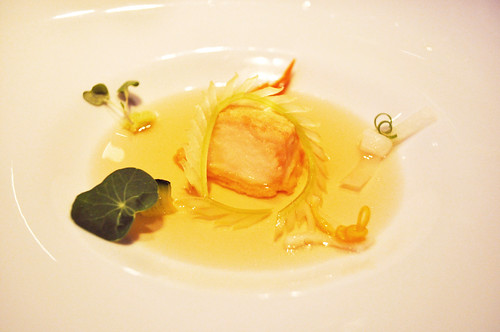
One of our captains disassembled the siphon, pouring the resulting dashi over the next course,"agedashi tofu" of scallop custard. The dashi included chili, bonito flakes, scallions, and other ingredients that escape me now. This was one of those courses that surprised you in taste, because it was prepared in the same was as you would find agedashi tofu, i.e., silken firm tofu that is cut into cubes and lightly dusted with potato starch or cornstarch and then deep fried until golden brown. Only difference is that instead of the silken firm tofu fried inside, it was scallop custard. The warm dashi enveloped the agedashi scallop custard with a concentration of Japanese flavors. The fried custard itself was silky and scallopy (go figure, haha) with the fried skin thin and crisp. It was quite mind-blowing that scallops could be made into a custard.
We even had a ceramic cup of the remaining dashi to drink at our leisure like tea/soup.
The eighth course was hamachi with Thai banana, sea salt, cucumber, coconut ice, and kaffir lime, served in an open glass orb. This course is inspired by the ocean -- tropical Thai ingredients and the resulting textures certainly emulated that. The chilliness of the coconut ice, the pungent citrus flavor of the kaffir lime, the crisp cukes, and the briny sea salt were an interesting combination of flavors, whereby they carpeted the tartare of yellowtail. I wasn't particularly fond of this dish -- the yellowtail seemed kinda uneventful to me -- but I appreciated the execution.
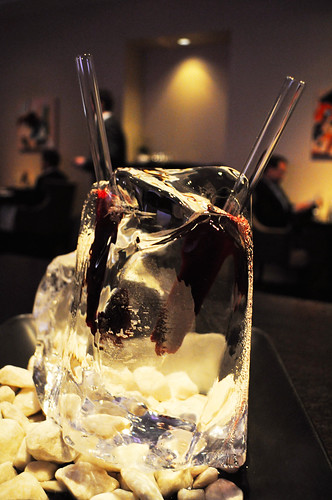
The following course finally brought our fancy centerpiece into the mix. It was (a block of) ice with beet juice, hibiscus, and licorice. The captains gave us thick glass straws for us to stick into the ice and slurp right up. What a loud slurp, indeed! The beet juice had a really robust punch on our palate -- very earthy and concentrated. The juice was perfectly chilled from the ice block, and the presentation couldn't have been more artistic.

This was the tenth course -- burn morels with ramps, fiddlehead fern, miner's lettuce, chanterelle custard, and asparagus. The stones on which the morels and such rested were indeed hot, creating an interesting subtle smokiness to it all. Each stone was a different exploration of mushroom, and again no shock value here, it was all unbelievably aesthetic. Marcus and I both really loved this dish -- even more of a surprise on Marcus's end as he has quite an aversion to mushrooms -- as it was really hearty, considering its focus was solely funghi and other vegetables.
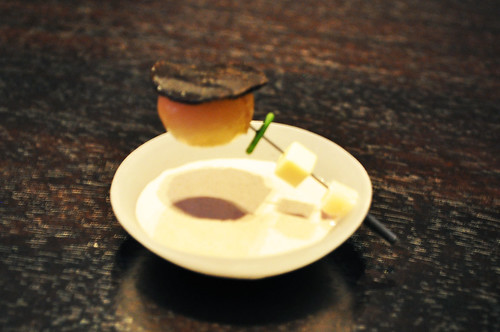
As segue into main course domain, one of the "classic" dishes at Alinea made an appearance once again. The hot potato with cold potato soup and Parmesan served in the usual soft wax bowl came with a pin (delicately containing black truffle topping the hot potato, followed by a few millimeters of fresh chive, fresh chive, and cubed butter positioned at a right angle to be used at the proper moment. Time is key with this li'l pup -- we were instructed to pull, in one fell swoop, the metal toothpick out, allowing its content (i.e., the black truffle and hot potato below it) to fall into the chilled potato soup, and then immediately drink the bowl's contents in one big gulp. It was just as I remembered it the first time 'round -- a wave of dual-umami action (the black truffle on the toothpick and the Parmesan in the soup) washing over our palates -- undoubtedly a primer for the savory courses ahead. Definitely in the hall of fame of favorite morsels!
The next course appears on the menu as lamb followed by ???!!!??? to denote what to expect. I had no idea what that meant until I saw what the kitchen sent over as the following course.
Formally called "Lamb 60" (i.e., lamb, sixty ways), this course began with a glass platter to be shared between the two of us, exquisitely decked with all kinds of garnishes, toppings, sides, flavors, condiments, etc. -- you name it. There were no diagrams or maps to navigate through it and neither were there any other instructions besides to taste as many as you can with the cuts of lamb that was to be brought out shortly. No one "flavor profile" was identical, so Marcus and I would each have our own "taste experiences" with the lamb. I equated this colorful assortment to Bertie Bott's Every Flavor Jelly Beans from the Harry Potter series -- you have no idea what you're going to get until you take a bite!

The trio of lamb with au jus comprised of (1) lamb shank, (2) lamb saddle, and (3) lamb loin. All were very tender at medium rare, in their own characteristic way -- the shank had that braised quality to it, the saddle had that soft, fall-apart-easily texture to it, and the loin was the usual cut of meat that most people are used to. Many of the "flavor profiles" were hit or miss for us -- I tended to like the fruits on the glass platter (berries, mostly), and Marcus just tried to have a taste of everything. A very interactive way to "play" with your food while exploring the depths of your palate -- just like the short rib course whereby each diner gets to "make" his/her own short rib raviolo with whatever accoutrement was presented.

Yet another signature Alinea dish, the next course was the
black truffle explosion in a tiny raviolo with romaine and Parmesan cheese, served in the infamous bottomless plate, best known as the "Antiplate" which serves as a white porcelain spoon presenter. InIstructions once again were to enjoy this in one bite, and it was just as I remembered it -- a black truffle/Italian version of the Shanghainese xiao long bao, i.e., soup-filled dumplings with an umami-explosion just like the hot potato but through a different texture and delivery catalyst. Once the explosion is intact, your palate will be a very happy one, and you'll want ten more of these!

Even by the fourteenth course, we were still endlessly wowed by the meticulous presentation -- it was {1} squab inspired by Joan Miró with {2} lavendar aromatics coming from the discard tub for good measure. Chef Achatz had been inspired on his recent trip to London, more specifically to his visit to the Tate Modern, where he encountered a painting by Spanish surrealist, Joan Miró, entitled Still Life with an Old Shoe. This painting can be seen as both a landscape and a still life, depicting a tabletop that works as both the backdrop for the latter and a delineation of the former. It moved him so much that when he returned to the Alinea kitchen, he and his staff brainstormed as to how to bring his art to life -- a survey of textures and flavors. The resemblance is uncanny, resulting in what was photographed above -- the culinary interpretation of Joan Miró, à la Achatz. The variegated position of spoons full of various things to accompany the bit of squab on one of the spoons. It was fun eating this, mainly because it was like a little puzzle trying to figure out which spoon to start with -- whether it would be based on taste or on which spoon would be the easiest to maneuver from the arrangement. The squab was cooked perfectly and the accompanying spoons all complemented it nicely (including some foie gras!) -- even had some unorthodox yet delicious pairings.
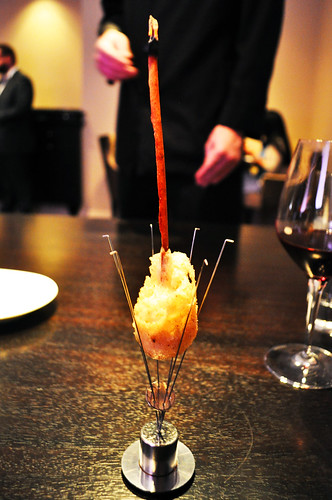
Just like the pheasant with green grape, walnut, and "burning leaves," the fifteenth course was served in the "
Squid" serviceware --
anjou pear tempura with onion, brie, and smoking cinnamon. While the burning cinnamon was tickling our noses, we were instructed to eat the fried ball right off the cinnamon stick, leaving that uneaten. The anjou pear tempura reminded me of that known Japanese novelty served in hibachi restaurants -- i.e., fried ice cream -- only a million times more gourmet because the creaminess was not from ice cream but from brie cheese. As it sat on my palate, the tempura collapsed onto its contents, as the warm, creamy brie oozed out over the caramelized, cubed pear. What an awesome take on a savory prelude to dessert!

The next course was sort of a palate cleanser --
ginger of five flavors, including fresh roots from Central America, Hawaii, and India, plated using the "Peacock" serviceware. Each metal skewer ("feather") is removable from the base, so we took one skewer at at time to sample the tiny ginger cubes of all shades and origins. Each one was more biting than its previous one. Certainly cleared any and all of our sinuses and wiped clean our palates quite efficiently.
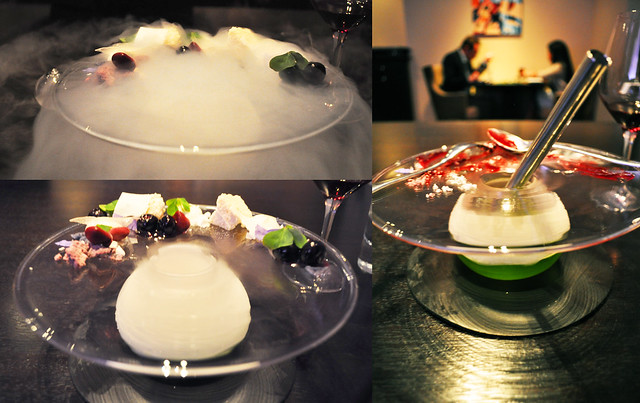
The first of the desserts finally arrived, served along what resembled an upside-down top-hat. It was a deconstructed blueberry shortcake with buttermilk and macadamia, {1} served atop a reservoir of sorrel snow by way of liquid nitrogen, poured by the captains. {2} We were told to begin with the blueberry shortcake along the brim of the top-hat apparatus -- subtly sweet and tart blueberries with a moist shortcake. {3} Next, we were given metal straws to drink the sorrel snow out of the reservoir -- it was chilly and had an apple juice taste and consistency. Probably the most noteworthy of serviceware (next to the dashi), as it seems to defy gravity and appear futuristic.
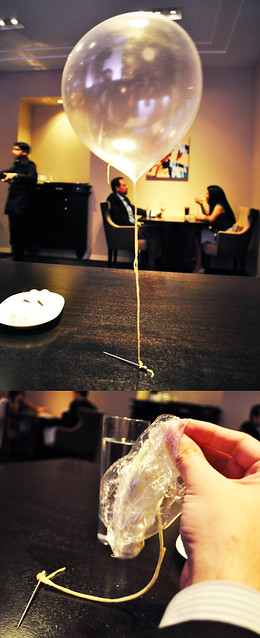
The second dessert, course number eighteen, was the most comedic and humorous -- {1} a green apple taffy balloon with helium and apple leather, which was entirely edible, minus the weighted needle (used for optional popping and holding down the helium-filled taffy). When will you ever say you were instructed to kiss your food? Ah, only at Alinea. Once we "kissed" the balloon, we had to inhale the helium deeply, raising our voices a couple octaves. Not going to lie -- it was hysterical to hear Marcus speak in a squeaky voice like that. The reason behind voices changing like that is because helium is less dense than air, so our sound waves can travel quicker, thereby resulting in that drastic pitch change. If you wanted to avoid inhaling the helium, you had the option of using the weighted needle to "pop" the balloon with ease. {2} Once the helium dissipated, we were left with the sticky taffy exterior of the balloon -- we practically had to lick it from our fingers, it was so sticky! Then, we ate the thick apple leather (almost like a denser licorice strand). Undoubtedly got flashbacks to my childhood visits to the candy shop with this dessert -- especially with that intense green apple flavor, refreshing the existence of Blowpops and Now and Laters in my mind.

The last course for the evening (the nineteenth!) was the grand finale of not only this tasting menu dinner, but of all possible desserts you can possibly serve. {1} The captains draped a thin silicone sheet over our table with some plating tools for what was to come, joking with us that it was dolphin skin (ugh, why am I so gullible?!). I knew it was almost time -- I knew Chef Achatz would be coming out from the kitchen to plate this very last dessert himself right here. The desperation and anticipation was so intense that it was palpable. I couldn't believe we would get to meet him again! Chef Achatz finally arrived at our table -- {2} placing the white chocolate piñata (i.e., the white orb made from a delicate, white chocolate shell) on the table, and {3} doing magical things on the mat with strawberry, English pea, lemon, and other fun treats. The table was literally his culinary canvas for this course!
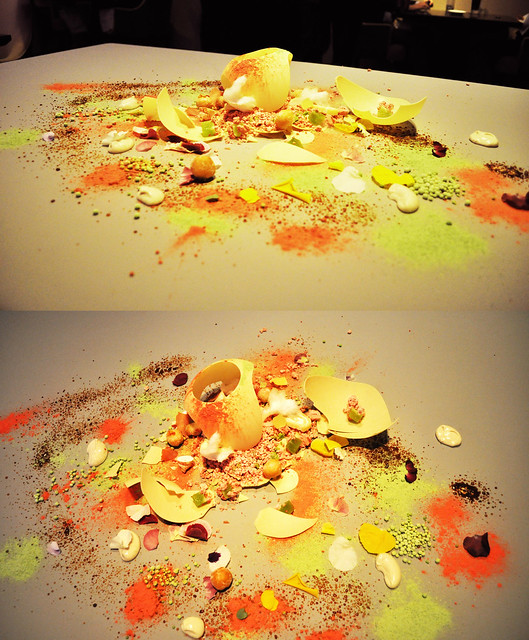
{1,2} At the very end, Chef Achatz performed the "piñata" part of the course, dropping the white chocolate orb right at the center of the table so it would break apart like a battered piñata upon impact against the mat-laden dining table, spilling out sweet treats that were hidden inside. I believe that it's usually a dark chocolate piñata, but I'm sure it was switched up to white chocolate for the spring and forthcoming summer seasons. Anyway, I almost felt guilty when I began to eat off the table for two reasons -- (1) etiquette dictates you should be eating off serviceware/plates -- it was second nature to keep stopping and asking myself what in the world I was doing, until I continued to remind myself we were at Alinea and that it was okay; and (2) what we had in front of us was a work of gastronomical, abstract art -- I hardly wanted to disturb the neon splashes of colors and the random placement of loose ingredients. Alas, curiosity got the best of us, and we were nomming away from the mat. We were scooping up strawberry and lemon powders, flash frozen English peas, broken shards of white chocolate, some edible flowers, and other treats. It may not have been my ideal dessert, flavor-wise, but it was undoubtedly so awe-inspiring and breath-taking that we couldn't help but hope we could applaud.
To accompany the white chocolate piñata, Marcus and I had some tea. The tea menu at Alinea is mostly comprised of Asian teas -- black, green, oolong, herbal, etc.
{1} I had an oolong tea from Taiwan, while {2} Marcus had the Alinea blend -- a blend of three green teas: gyokuro, kukicha, and yamcha. Both were excellent.
Findings: All in all, our dinner at Alinea was absolutely wonderful with lots of ooh-ing, aahing, and wow-ing. With my mind mostly pre-blown from my first visit a year and a half before, I was concerned that I'd be unimpressed, or even worse, bored. With that being said, I am happy to report that despite my reservations about going once again, Alinea was still slyly able to inspire and tickle my palate both aesthetically and gustatorily with its theatricality in presentation and surprisingly pleasant profiles of flavor. Even the possibility of overhyping Marcus, who had heard me rave on and on about the restaurant and read my review many times over, had become a subject we had long defenestrated from the very first course of our dinner. There was no turning back, and fortunately, Alinea made that very easy for us. It is no doubt then that Chef Achatz takes the restaurant's unofficial mantra, "Toward creativity," very seriously -- it's like an evergrowing tree of new ideas to execute in the dining room for its diners to behold and drop their jaws in a chorus of "ZOMG!" Martin Kastner of Crucial Detail brings these ideas and concepts to life beautifully with his one-of-a-kind designs -- all the courses, except for two or three, had completely different serviceware than I had observed just a year and a half ago. How unbelievable is that?! I also have to add that going in with a set of enlightened eyes (something I usually discourage myself from doing) actually enhanced the experience some more for me -- I had a more profound understanding of Chef Achatz's philosophy behind Alinea after reading Life, On the Line, of Crucial Detail's serviceware, and essentially of any little details I may have missed the first time around. Going to Alinea again was like rereading your favorite novel for the second time, catching all of those little subtleties with more careful eyes and more weathered from life experiences (only here, it's culinary miles under one's tummy).
Another thing I had reservations about was the service. My last visit, while my guests and I had a lovely time, I felt it was a little detached -- not at all the extreme of unattentive and rude, but it was, simply put, sterile. It seemed that the novelty of Chef Achatz's modernist and imaginative approach to cuisine had wore off, and perhaps the theatrics of the avant-garde were becoming quotidian. Keeping that spark in your voice and gestures, as if every time is your first time, is certainly a challenge, but that's what makes restaurants like Alinea so special. With that being said, it was really refreshing and comforting to know that the initial impression I had about the service that had seemed so distant and unexcited had faded away. The service team couldn't have been any more welcoming and kept the appropriate distance in between courses. They were always smiling and enthusiastic when presenting the dishes -- even added some light humor in the mix to break the sounds of clearing serviceware and clinking glasses (no ambient sounds are played in the background of the dining rooms or kitchen to encourage sole focus on the cuisine at hand). Very well done.
In summary, I believe I can say we had a spectacular celebratory meal at Alinea -- one that will go down the annals of our gastronomic adventures, adding to the figurative hall of Michelin stars that we've accumulated together. Not a shabby way of celebrating our second anniversary, if I do say so myself! Plus, having had endured all of those injuries, I think we deserved a break or two! :P Not only was it amazing to experience the restaurant's awe-inspiring phenomena once again, but it was even more of a treat to witness Marcus's first time at this modernist foodie's mecca. I was totally dead on with my first review -- with a meal so mind-blowing, playful, multi-sensory, forward thinking, dynamic, spot-on progression -- it was really difficult finding the right words to ensure I convey every bit of awesome we experienced. So the only way to cure this dissonance with sensory experience and written perception is to take the leap and make a reservation to see for yourself. Sure, it's a little steep -- probably the most you'll spend on any meal in your lifetime -- but I promise it is surely worth it. Chef Achatz, Mr. Kokonas, and Mr. Kastner have worked up quite enterprise on North Halsted in Lincoln Park -- so prepare to have your mind blown and your palate enlightened. It'll be the best (if not, pretty freaking close), most memorable meal you'll ever have -- besides, what other fine dining establishment can you say you'd be able to play with your food? Not many others I gather! :P
Price point: $210 per person for chef's tasting, $24 for for champagne cocktail, $8-12 for each pot of tea.
--May 17, 2012
Alinea
1723 North Halsted
Chicago, Illinois 60614



